A Lightweight Cross-Gated Dual-Branch Attention Network for Colon and Lung Cancer Diagnosis from Histopathological Images
Abstract
1. Introduction
- A fully end-to-end dual-branch attention network that unifies global and local representations without intermediate processing stages;
- A cross-gated fusion mechanism that enhances feature complementarity between EfficientNetV2-B0 and MobileNetV3-Small while minimizing parameter overhead;
- An empirical validation showing that high classification accuracy and low computational cost can coexist, evaluated on the LC25000 dataset of colon and lung histopathological images.
2. Related Works
3. Proposed Model
3.1. Dataset Used
3.2. Model Architecture
3.2.1. Dual-Branch Lightweight Fusion
3.2.2. Cross-Gated Fusion
3.2.3. Hybrid Descriptor and Classification Head
3.3. Visual Saliency Maps with Grad-CAM
4. Results and Discussion
4.1. Results Analysis
4.2. Visual Saliency Maps for Model Explainability
4.3. Discussion
5. Conclusions
Author Contributions
Funding
Institutional Review Board Statement
Informed Consent Statement
Data Availability Statement
Acknowledgments
Conflicts of Interest
Abbreviations
| AI | Artificial Intelligence |
| CAD | Computer-Aided Diagnosis |
| CNN | Convolutional Neural Network |
| DL | Deep Learning |
| ECA | Efficient Channel Attention |
| GeM | Generalized Mean Pooling |
| GAP | Global Average Pooling |
| GMP | Global Max Pooling |
| CGF | Cross-Gated Fusion block |
| BN | Batch Normalization |
| LN | Layer Normalization |
| ReLU | Rectified Linear Unit |
| Grad-CAM | Gradient-weighted Class Activation Mapping |
| MCC | Matthews Correlation Coefficient |
| ROC | Receiver Operating Characteristic |
| PR | Precision–Recall |
| AUC | Area Under the Curve |
| H&E | Hematoxylin and Eosin staining |
| KELM | Kernel Extreme Learning Machine |
| SVM | Support Vector Machine |
| AdBet-WOA | Adaptive β-Hill Climbing Whale Optimization Algorithm |
| MPADL-LC3 | Marine Predators Algorithm Deep Learning model for LC25000 |
| BERTL-HIALCCD | BERT-like Hybrid Integrated Attention Lung–Colon Cancer Detector |
| HIELCC-EDL | Hybrid Ensemble Lung–Colon Cancer Classifier based on Deep Learning |
| LMVT | Lightweight Multi-Vision Transformer |
| ViT-DCNN | Vision Transformer with Deformable Convolutional Neural Network |
| BiLight-Attn-LC | Proposed Bidirectional Lightweight Attention Network for Lung and Colon Classification |
| AdamW | Adaptive Moment Estimation with Decoupled Weight Decay Optimizer |
| VRAM | Video Random Access Memory |
| TPU/GPU | Tensor Processing Unit/Graphics Processing Unit |
| TP | True Positives |
| TN | True Negatives |
| FP | False Positives |
| FN | False Negatives |
| TPR | True Positive Rate |
| FPR | False Positive Rate |
References
- Sriharikrishnaa, S.; Suresh, P.S.; Prasada, K.S. An introduction to fundamentals of cancer biology. In Optical Polarimetric Modalities for Biomedical Research; Springer International Publishing: Cham, Switzerland, 2023; pp. 307–330. [Google Scholar]
- Dai, X.; Xi, M.; Li, J. Cancer metastasis: Molecular mechanisms and therapeutic interventions. Mol. Biomed. 2025, 6, 20. [Google Scholar] [CrossRef] [PubMed]
- Olfatifar, M.; Rafiei, F.; Sadeghi, A.; Ataei, E.; Habibi, M.A.; Pezeshgi Modarres, M.; Ghalavand, Z.; Houri, H. Assessing the colorectal cancer landscape: A comprehensive exploration of future trends in 216 countries and territories from 2021 to 2040. J. Epidemiol. Glob. Health 2025, 15, 5. [Google Scholar] [CrossRef] [PubMed]
- Nie, J.X.; Xie, Q.; Yuan, Y.; Liu, M.Y.; Du, J.K.; Li, N.; Zou, Q.F. Rising Incidence of Total and Early-Onset Colorectal Cancer: A Global Perspective on Burden, Risk Factors, and Projections to 2031. J. Gastrointest. Cancer 2025, 56, 138. [Google Scholar] [CrossRef] [PubMed]
- Zhang, X.; Yang, L.; Liu, S.; Cao, L.L.; Wang, N.; Li, H.C.; Ji, J.F. Interpretation on the report of global cancer statistics 2022. Zhonghua Zhong Liu Za Zhi Chin. J. Oncol. 2024, 46, 710–721. [Google Scholar]
- Bray, F.; Laversanne, M.; Sung, H.; Ferlay, J.; Siegel, R.L.; Soerjomataram, I.; Jemal, A. Global cancer statistics 2022: GLOBOCAN estimates of incidence and mortality worldwide for 36 cancers in 185 countries. CA Cancer J. Clin. 2024, 74, 229–263. [Google Scholar] [CrossRef]
- Luo, G.; Zhang, Y.; Rumgay, H.; Morgan, E.; Langselius, O.; Vignat, J.; Colombet, M.; Bray, F. Estimated worldwide variation and trends in incidence of lung cancer by histological subtype in 2022 and over time: A population-based study. Lancet Respir. Med. 2025, 13, 348–363. [Google Scholar] [CrossRef]
- Ning, J.; Ge, T.; Jiang, M.; Jia, K.; Wang, L.; Li, W.; Chen, B.; Liu, Y.; Wang, H.; Zhao, S.; et al. Early diagnosis of lung cancer: Which is the optimal choice? Aging 2021, 13, 6214. [Google Scholar] [CrossRef]
- Crosby, D.; Bhatia, S.; Brindle, K.M.; Coussens, L.M.; Dive, C.; Emberton, M.; Esener, S.; Fitzgerald, R.C.; Gambhir, S.S.; Kuhn, P.; et al. Early detection of cancer. Science 2022, 375, eaay9040. [Google Scholar] [CrossRef]
- Borczuk, A.C. Updates in grading and invasion assessment in lung adenocarcinoma. Mod. Pathol. 2022, 35, 28–35. [Google Scholar] [CrossRef]
- Succony, L.; Rassl, D.M.; Barker, A.P.; McCaughan, F.M.; Rintoul, R.C. Adenocarcinoma spectrum lesions of the lung: Detection, pathology and treatment strategies. Cancer Treat. Rev. 2021, 99, 102237. [Google Scholar] [CrossRef]
- Zhang, S. Adenocarcinoma. In Diagnostic Imaging of Lung Cancers; Springer Nature: Singapore, 2024; pp. 3–49. [Google Scholar]
- Berezowska, S.; Maillard, M.; Keyter, M.; Bisig, B. Pulmonary squamous cell carcinoma and lymphoepithelial carcinoma–morphology, molecular characteristics and differential diagnosis. Histopathology 2024, 84, 32–49. [Google Scholar] [CrossRef] [PubMed]
- Lau, S.C.; Pan, Y.; Velcheti, V.; Wong, K.K. Squamous cell lung cancer: Current landscape and future therapeutic options. Cancer Cell 2022, 40, 1279–1293. [Google Scholar] [CrossRef] [PubMed]
- Mascalchi, M.; Puliti, D.; Cavigli, E.; O Cortés-Ibáñez, F.; Picozzi, G.; Carrozzi, L.; Gorini, G.; Delorme, S.; Zompatori, M.; De Luca, G.R.; et al. Large cell carcinoma of the lung: LDCT features and survival in screen-detected cases. Eur. J. Radiol. 2024, 179, 111679. [Google Scholar] [CrossRef] [PubMed]
- Zhu, Z.; Liu, Y.; Xu, H.; Ning, H.; Xia, Y.; Shen, L. Combined large cell neuroendocrine carcinoma, lung adenocarcinoma, and squamous cell carcinoma: A case report and review of the literature. J. Cardiothorac. Surg. 2023, 18, 254. [Google Scholar] [CrossRef]
- Galuppini, F.; Fassan, M.; Mastracci, L.; Gafà, R.; Mele, M.L.; Lazzi, S.; Remo, A.; Parente, P.; D’aMuri, A.; Mescoli, C.; et al. The histomorphological and molecular landscape of colorectal adenomas and serrated lesions. Pathologica 2021, 113, 218. [Google Scholar] [CrossRef]
- Tseng, L.J.; Matsuyama, A.; MacDonald-Dickinson, V. Histology: The gold standard for diagnosis? Can. Vet. J. 2023, 64, 389. [Google Scholar]
- Dunn, C.; Brettle, D.; Cockroft, M.; Keating, E.; Revie, C.; Treanor, D. Quantitative assessment of H&E staining for pathology: Development and clinical evaluation of a novel system. Diagn. Pathol. 2024, 19, 42. [Google Scholar] [CrossRef]
- Bokhorst, J.-M.; Ciompi, F.; Öztürk, S.K.; Erdogan, A.S.O.; Vieth, M.; Dawson, H.; Kirsch, R.; Simmer, F.; Sheahan, K.; Lugli, A.; et al. Fully automated tumor bud assessment in hematoxylin and eosin-stained whole slide images of colorectal cancer. Mod. Pathol. 2023, 36, 100233. [Google Scholar] [CrossRef]
- Mezei, T.; Kolcsár, M.; Joó, A.; Gurzu, S. Image analysis in histopathology and cytopathology: From early days to current perspectives. J. Imaging 2024, 10, 252. [Google Scholar] [CrossRef]
- Dika, E.; Curti, N.; Giampieri, E.; Veronesi, G.; Misciali, C.; Ricci, C.; Castellani, G.; Patrizi, A.; Marcelli, E. Advantages of manual and automatic computer-aided compared to traditional histopathological diagnosis of melanoma: A pilot study. Pathol.-Res. Pract. 2022, 237, 154014. [Google Scholar] [CrossRef]
- Shafi, S.; Parwani, A.V. Artificial intelligence in diagnostic pathology. Diagn. Pathol. 2023, 18, 109. [Google Scholar] [CrossRef] [PubMed]
- Zhang, D.Y.; Venkat, A.; Khasawneh, H.; Sali, R.; Zhang, V.; Pei, Z. Implementation of digital pathology and artificial intelligence in routine pathology practice. Lab. Investig. 2024, 104, 102111. [Google Scholar] [CrossRef] [PubMed]
- Hijazi, A.; Bifulco, C.; Baldin, P.; Galon, J. Digital pathology for better clinical practice. Cancers 2024, 16, 1686. [Google Scholar] [CrossRef] [PubMed]
- Bahadir, C.D.; Omar, M.; Rosenthal, J.; Marchionni, L.; Liechty, B.; Pisapia, D.J.; Sabuncu, M.R. Artificial intelligence applications in histopathology. Nat. Rev. Electr. Eng. 2024, 1, 93–108. [Google Scholar] [CrossRef]
- Shmatko, A.; Ghaffari Laleh, N.; Gerstung, M.; Kather, J.N. Artificial intelligence in histopathology: Enhancing cancer research and clinical oncology. Nat. Cancer 2022, 3, 1026–1038. [Google Scholar] [CrossRef]
- Srinidhi, C.L.; Ciga, O.; Martel, A.L. Deep neural network models for computational histopathology: A survey. Med. Image Anal. 2021, 67, 101813. [Google Scholar] [CrossRef]
- Kshatri, S.S.; Singh, D. Convolutional neural network in medical image analysis: A review. Arch. Comput. Methods Eng. 2023, 30, 2793–2810. [Google Scholar] [CrossRef]
- Wu, Y.; Cheng, M.; Huang, S.; Pei, Z.; Zuo, Y.; Liu, J.; Yang, K.; Zhu, Q.; Zhang, J.; Hong, H. Recent advances of deep learning for computational histopathology: Principles and applications. Cancers 2022, 14, 1199. [Google Scholar] [CrossRef]
- Ben Hamida, A.; Devanne, M.; Weber, J.; Truntzer, C.; Derangère, V.; Ghiringhelli, F.; Forestier, G.; Wemmert, C. Deep learning for colon cancer histopathological images analysis. Comput. Biol. Med. 2021, 136, 104730. [Google Scholar] [CrossRef]
- Alahmadi, A. Towards ovarian cancer diagnostics: A vision transformer-based computer-aided diagnosis framework with enhanced interpretability. Results Eng. 2024, 23, 102651. [Google Scholar] [CrossRef]
- Tummala, S.; Kadry, S.; Nadeem, A.; Rauf, H.T.; Gul, N. An explainable classification method based on complex scaling in histopathology images for lung and colon cancer. Diagnostics 2023, 13, 1594. [Google Scholar] [CrossRef]
- Riasatian, A.; Babaie, M.; Maleki, D.; Kalra, S.; Valipour, M.; Hemati, S.; Zaveri, M.; Safarpoor, A.; Shafiei, S.; Afshari, M.; et al. Fine-tuning and training of densenet for histopathology image representation using tcga diagnostic slides. Med. Image Anal. 2021, 70, 102032. [Google Scholar] [CrossRef] [PubMed]
- Attallah, O.; Aslan, M.F.; Sabanci, K. A framework for lung and colon cancer diagnosis via lightweight deep learning models and transformation methods. Diagnostics 2022, 12, 2926. [Google Scholar] [CrossRef] [PubMed]
- Masud, M.; Sikder, N.; Nahid, A.A.; Bairagi, A.K.; AlZain, M.A. A machine learning approach to diagnosing lung and colon cancer using a deep learning-based classification framework. Sensors 2021, 21, 748. [Google Scholar] [CrossRef] [PubMed]
- Kumar, N.; Sharma, M.; Singh, V.P.; Madan, C.; Mehandia, S. An empirical study of handcrafted and dense feature extraction techniques for lung and colon cancer classification from histopathological images. Biomed. Signal Process. Control 2022, 75, 103596. [Google Scholar] [CrossRef]
- Ochoa-Ornelas, R.; Gudiño-Ochoa, A.; García-Rodríguez, J.A. A hybrid deep learning and machine learning approach with Mobile-EfficientNet and Grey Wolf Optimizer for lung and colon cancer histopathology classification. Cancers 2024, 16, 3791. [Google Scholar] [CrossRef]
- Borkowski, A.A.; Bui, M.M.; Thomas, L.B.; Wilson, C.P.; DeLand, L.A.; Mastorides, S.M. Lung and colon cancer histopathological image dataset (lc25000). arXiv 2019, arXiv:1912.12142. [Google Scholar] [CrossRef]
- DeVoe, K.; Takahashi, G.; Tarshizi, E.; Sacker, A. Evaluation of the precision and accuracy in the classification of breast histopathology images using the MobileNetV3 model. J. Pathol. Inform. 2024, 15, 100377. [Google Scholar] [CrossRef]
- Azmoodeh-Kalati, M.; Shabani, H.; Maghareh, M.S.; Barzegar, Z.; Lashgari, R. Leveraging an ensemble of EfficientNetV1 and EfficientNetV2 models for classification and interpretation of breast cancer histopathology images. Sci. Rep. 2025, 15, 21541. [Google Scholar] [CrossRef]
- Ochoa-Ornelas, R.; Gudiño-Ochoa, A.; García-Rodríguez, J.A.; Uribe-Toscano, S. Enhancing early lung cancer detection with MobileNet: A comprehensive transfer learning approach. Frankl. Open 2025, 10, 100222. [Google Scholar] [CrossRef]
- Ochoa-Ornelas, R.; Gudiño-Ochoa, A.; García-Rodríguez, J.A.; Uribe-Toscano, S. A robust transfer learning approach with histopathological images for lung and colon cancer detection using EfficientNetB3. Healthc. Anal. 2025, 7, 100391. [Google Scholar] [CrossRef]
- Ochoa-Ornelas, R.; Gudiño-Ochoa, A.; García-Rodríguez, J.A.; Uribe-Toscano, S. Lung and colon cancer detection with InceptionResNetV2: A transfer learning approach. J. Res. Dev./Rev. De Investig. Desarro. 2024, 10, e11025113. [Google Scholar] [CrossRef]
- Gowthamy, J.; Ramesh, S. A novel hybrid model for lung and colon cancer detection using pre-trained deep learning and KELM. Expert Syst. Appl. 2024, 252, 124114. [Google Scholar] [CrossRef]
- Bhattacharya, A.; Saha, B.; Chattopadhyay, S.; Sarkar, R. Deep feature selection using adaptive β-Hill Climbing aided whale optimization algorithm for lung and colon cancer detection. Biomed. Signal Process. Control 2023, 83, 104692. [Google Scholar] [CrossRef]
- Roy, A.; Saha, P.; Gautam, N.; Schwenker, F.; Sarkar, R. Adaptive genetic algorithm based deep feature selector for cancer detection in lung histopathological images. Sci. Rep. 2025, 15, 4803. [Google Scholar] [CrossRef] [PubMed]
- Mengash, H.A.; Alamgeer, M.; Maashi, M.; Othman, M.; Hamza, M.A.; Ibrahim, S.S.; Zamani, A.S.; Yaseen, I. Leveraging marine predators algorithm with deep learning for lung and colon cancer diagnosis. Cancers 2023, 15, 1591. [Google Scholar] [CrossRef] [PubMed]
- AlGhamdi, R.; Asar, T.O.; Assiri, F.Y.; Mansouri, R.A.; Ragab, M. Al-biruni Earth radius optimization with transfer learning based histopathological image analysis for lung and colon cancer detection. Cancers 2023, 15, 3300. [Google Scholar] [CrossRef]
- Alotaibi, M.; Alshardan, A.; Maashi, M.; Asiri, M.M.; Alotaibi, S.R.; Yafoz, A.; Alsini, R.; Khadidos, A.O. Exploiting histopathological imaging for early detection of lung and colon cancer via ensemble deep learning model. Sci. Rep. 2024, 14, 20434. [Google Scholar] [CrossRef]
- Debnath, J.; Pranta, A.S.U.K.; Hossain, A.; Sakib, A.; Rahman, H.; Haque, R.; Ahmed, M.; Reza, A.W.; Swapno, S.M.M.; Appaji, A. LMVT: A hybrid vision transformer with attention mechanisms for efficient and explainable lung cancer diagnosis. Inform. Med. Unlocked 2025, 57, 101669. [Google Scholar] [CrossRef]
- Pal, A.; Rai, H.M.; Yoo, J.; Lee, S.R.; Park, Y. ViT-DCNN: Vision Transformer with Deformable CNN Model for Lung and Colon Cancer Detection. Cancers 2025, 17, 3005. [Google Scholar] [CrossRef]
- Shahadat, N.; Lama, R.; Nguyen, A. Lung and colon cancer detection using a deep ai model. Cancers 2024, 16, 3879. [Google Scholar] [CrossRef]
- Attallah, O. Multi-Domain Feature Incorporation of Lightweight Convolutional Neural Networks and Handcrafted Features for Lung and Colon Cancer Diagnosis. Technologies 2025, 13, 173. [Google Scholar] [CrossRef]
- Attallah, O. Lung and colon cancer classification using multiscale deep features integration of compact convolutional neural networks and feature selection. Technologies 2025, 13, 54. [Google Scholar] [CrossRef]
- Raju, A.S.N.; Venkatesh, K.; Padmaja, B.; Kumar, C.N.S.; Patnala, P.R.M.; Lasisi, A.; Islam, S.; Razak, A.; Khan, W.A. Exploring vision transformers and XGBoost as deep learning ensembles for transforming carcinoma recognition. Sci. Rep. 2024, 14, 30052. [Google Scholar] [CrossRef]
- Hasan, M.A.; Haque, F.; Sabuj, S.R.; Sarker, H.; Goni, M.O.F.; Rahman, F.; Rashid, M.M. An end-to-end lightweight multi-scale cnn for the classification of lung and colon cancer with xai integration. Technologies 2024, 12, 56. [Google Scholar] [CrossRef]
- Ukwuoma, C.C.; Cai, D.; Eziefuna, E.O.; Oluwasanmi, A.; Abdi, S.F.; Muoka, G.W.; Thomas, D.; Sarpong, K. Enhancing histopathological medical image classification for Early cancer diagnosis using deep learning and explainable AI–LIME & SHAP. Biomed. Signal Process. Control 2025, 100, 107014. [Google Scholar]
- Yang, M.; Dong, X.; Zhang, W.; Xie, P.; Li, C.; Chen, S. A feature fusion module based on complementary attention for medical image segmentation. Displays 2024, 84, 102811. [Google Scholar] [CrossRef]
- Xu, W.; Wan, Y. ELA: Efficient local attention for deep convolutional neural networks. arXiv 2024, arXiv:2403.01123. [Google Scholar] [CrossRef]
- Nirthika, R.; Manivannan, S.; Ramanan, A.; Wang, R. Pooling in convolutional neural networks for medical image analysis: A survey and an empirical study. Neural Comput. Appl. 2022, 34, 5321–5347. [Google Scholar] [CrossRef]
- Zhao, L.; Zhang, Z. An improved pooling method for convolutional neural networks. Sci. Rep. 2024, 14, 1589. [Google Scholar] [CrossRef]
- Wang, C.; Nie, R.; Cao, J.; Wang, X.; Zhang, Y. IGNFusion: An unsupervised information gate network for multimodal medical image fusion. IEEE J. Sel. Top. Signal Process. 2022, 16, 854–868. [Google Scholar] [CrossRef]
- Xu, L.; Tang, Q.; Zheng, B.; Lv, J.; Li, W.; Zeng, X. CGFTrans: Cross-modal global feature fusion transformer for medical report generation. IEEE J. Biomed. Health Inform. 2024, 28, 5600–5612. [Google Scholar] [CrossRef] [PubMed]
- Zheng, J.; Liu, H.; Feng, Y.; Xu, J.; Zhao, L. CASF-Net: Cross-attention and cross-scale fusion network for medical image segmentation. Comput. Methods Programs Biomed. 2023, 229, 107307. [Google Scholar] [CrossRef] [PubMed]
- Liu, J.; Ren, J.; Lu, Z.; He, W.; Cui, M.; Zhang, Z.; Bai, R. Cross-document attention-based gated fusion network for automated medical licensing exam. Expert Syst. Appl. 2022, 205, 117588. [Google Scholar] [CrossRef]
- Balestriero, R.; Baraniuk, R.G. Batch normalization explained. arXiv 2022, arXiv:2209.14778. [Google Scholar] [CrossRef]
- Zhou, P.; Xie, X.; Lin, Z.; Yan, S. Towards understanding convergence and generalization of AdamW. IEEE Trans. Pattern Anal. Mach. Intell. 2024, 46, 6486–6493. [Google Scholar] [CrossRef]
- Alimisis, F.; Islamov, R.; Lucchi, A. Why do we need warm-up? A theoretical perspective. arXiv 2025, arXiv:2510.03164. [Google Scholar] [CrossRef]
- Liu, Z. Super convergence cosine annealing with warm-up learning rate. In Proceedings of the 2nd International Conference on Artificial Intelligence, Big Data and Algorithms (CAIBDA 2022), Nanjing, China, 17–19 June 2022; VDE: Berlin, Germany, 2022; pp. 1–7. [Google Scholar]
- Ochoa-Ornelas, R.; Gudiño-Ochoa, A.; Rodríguez González, A.Y.; Trujillo, L.; Fajardo-Delgado, D.; Puga-Nathal, K.L. Lightweight and Accurate Deep Learning for Strawberry Leaf Disease Recognition: An Interpretable Approach. AgriEngineering 2025, 7, 355. [Google Scholar] [CrossRef]
- Suara, S.; Jha, A.; Sinha, P.; Sekh, A.A. Is Grad-CAM explainable in medical images? In Proceedings of the International Conference on Computer Vision and Image Processing, Jammu, India, 3–5 November 2023; Springer Nature: Cham, Switzerland; pp. 124–135. [Google Scholar]
- Chaddad, A.; Hu, Y.; Wu, Y.; Wen, B.; Kateb, R. Generalizable and explainable deep learning for medical image computing: An overview. Curr. Opin. Biomed. Eng. 2025, 33, 100567. [Google Scholar] [CrossRef]
- Gudiño-Ochoa, A.; García-Rodríguez, J.A.; Ochoa-Ornelas, R.; Ruiz-Velazquez, E.; Uribe-Toscano, S.; Cuevas-Chávez, J.I.; Sánchez-Arias, D.A. Non-Invasive Multiclass Diabetes Classification Using Breath Biomarkers and Machine Learning with Explainable AI. Diabetology 2025, 6, 51. [Google Scholar] [CrossRef]


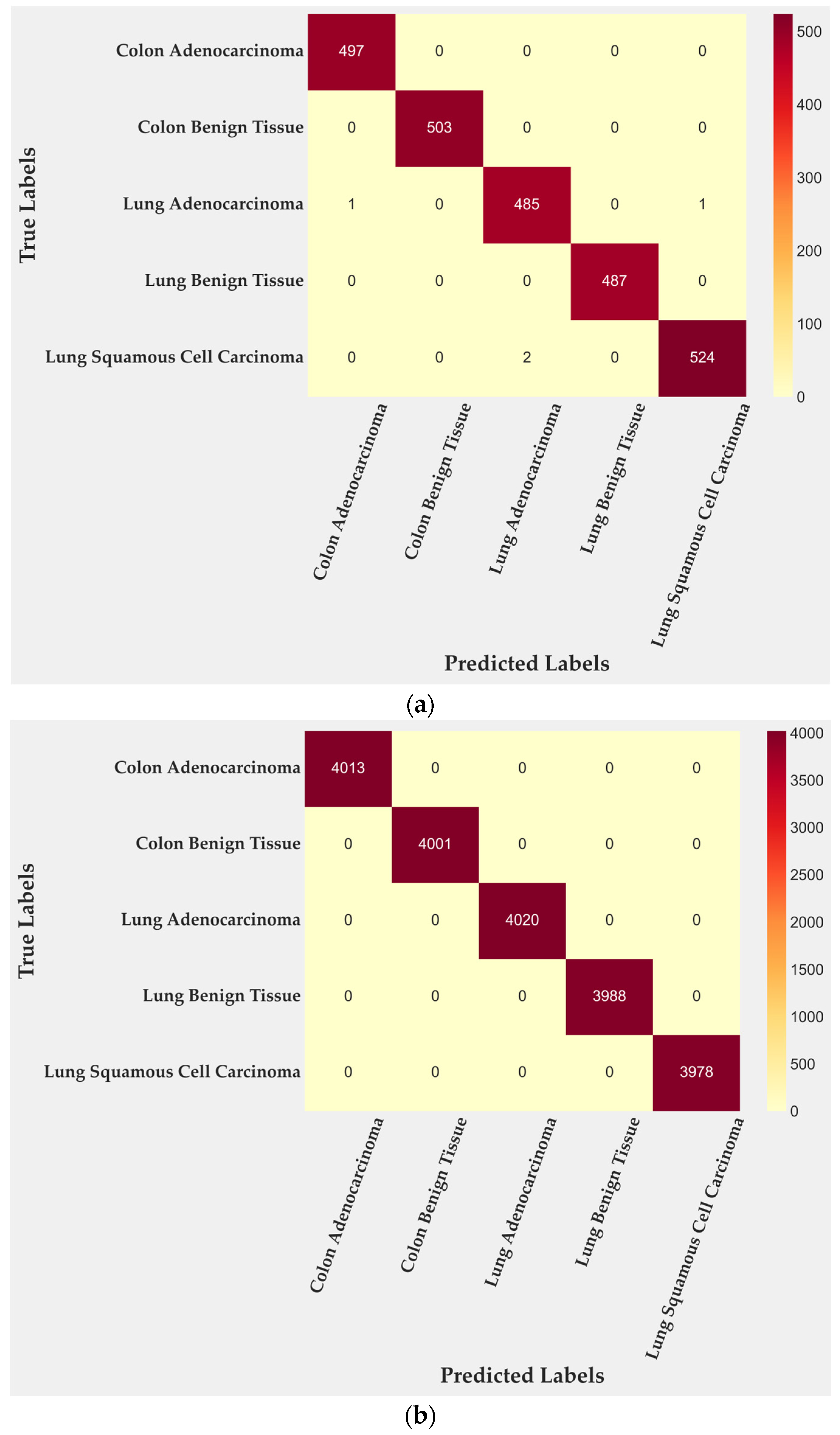
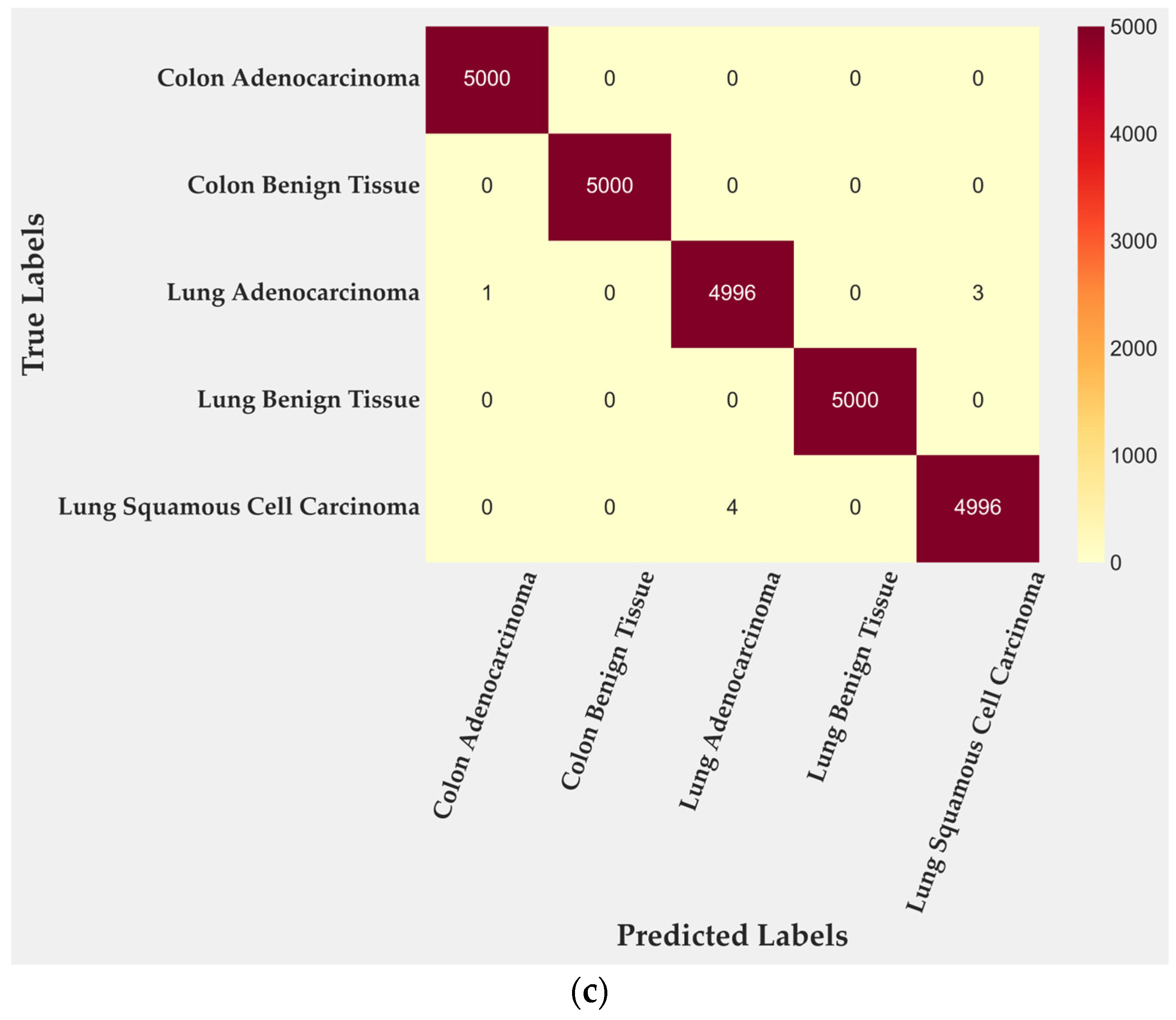
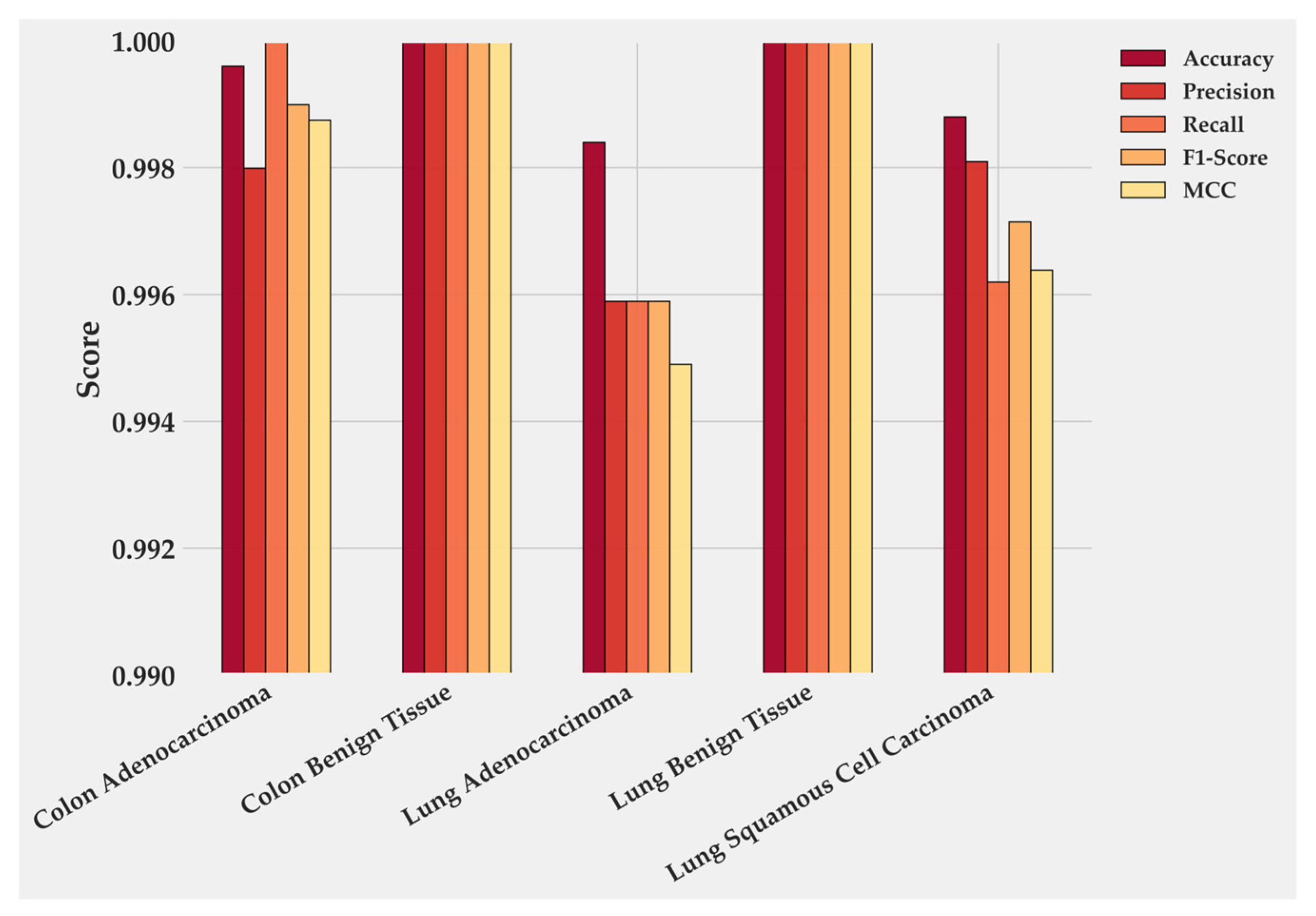
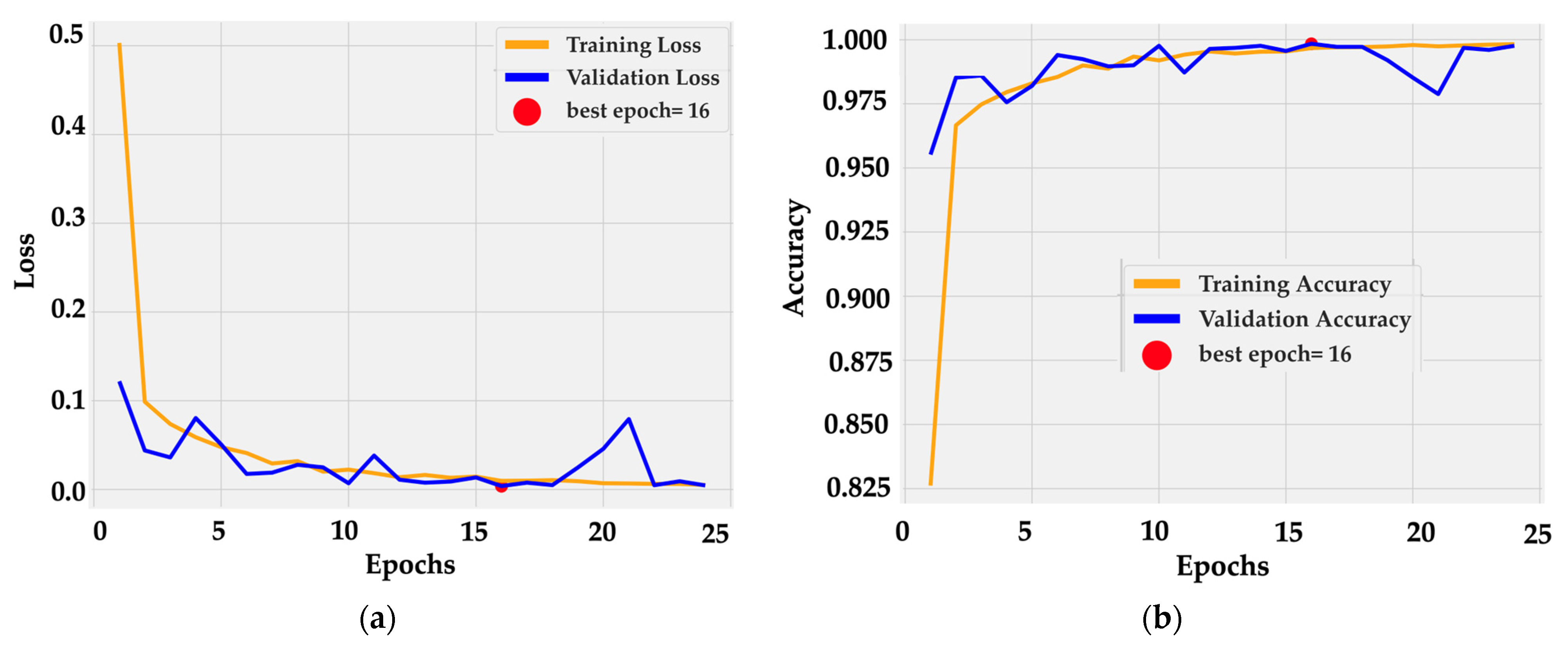
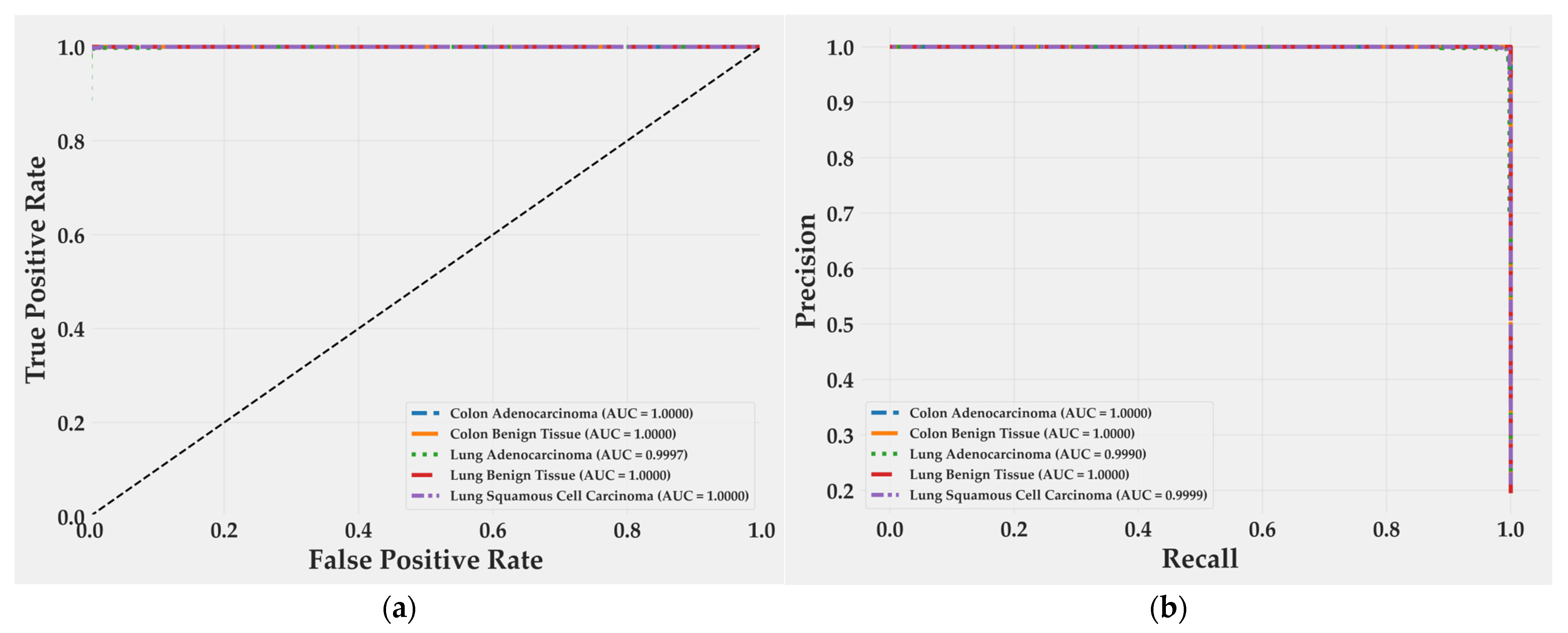
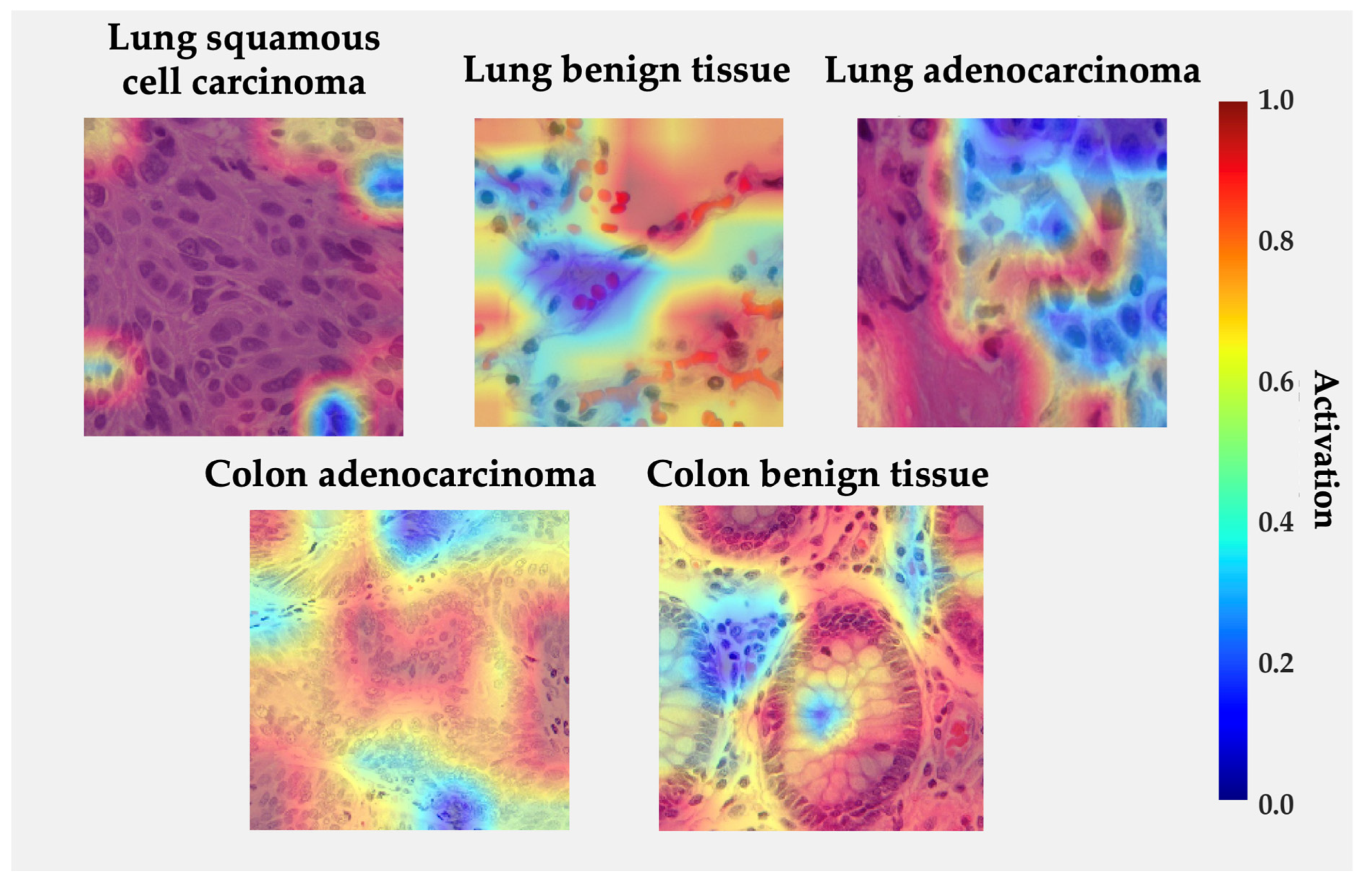
| Class | Description | Number of Images |
|---|---|---|
| Lung benign tissue | Normal pulmonary parenchyma | 5000 |
| Lung adenocarcinoma | Malignant gland-forming epithelium | 5000 |
| Lung squamous cell carcinoma | Keratinizing malignant epithelium of bronchial origin | 5000 |
| Colon adenocarcinoma | Dysplastic glandular proliferation in colonic mucosa | 5000 |
| Colon benign tissue | Normal colonic mucosa without neoplastic changes | 5000 |
| Dataset | Class | Precision | Recall | F1-Score | Accuracy | MCC |
|---|---|---|---|---|---|---|
| Test | Colon Adenocarcinoma | 0.9979 | 1.000 | 0.9989 | 0.9996 | 0.9987 |
| Colon Benign Tissue | 1.000 | 1.000 | 1.000 | 1.000 | 1.000 | |
| Lung Adenocarcinoma | 0.9958 | 0.9958 | 0.9958 | 0.9984 | 0.9948 | |
| Lung Benign Tissue | 1.000 | 1.000 | 1.000 | 1.000 | 1.000 | |
| Lung Squamous Cell Carcinoma | 0.9989 | 0.9961 | 0.9714 | 0.9988 | 0.9963 | |
| Train | Colon Adenocarcinoma | 1.000 | 1.000 | 1.000 | 1.000 | 1.000 |
| Colon Benign Tissue | 1.000 | 1.000 | 1.000 | 1.000 | 1.000 | |
| Lung Adenocarcinoma | 1.000 | 1.000 | 1.000 | 1.000 | 1.000 | |
| Lung Benign Tissue | 1.000 | 1.000 | 1.000 | 1.000 | 1.000 | |
| Lung Squamous Cell Carcinoma | 1.000 | 1.000 | 1.000 | 1.000 | 1.000 | |
| All | Colon Adenocarcinoma | 0.9998 | 1.000 | 0.9999 | 0.9999 | 0.9998 |
| Colon Benign Tissue | 1.000 | 1.000 | 1.000 | 1.000 | 1.000 | |
| Lung Adenocarcinoma | 0.9992 | 0.9992 | 0.9992 | 0.9996 | 0.9990 | |
| Lung Benign Tissue | 1.000 | 1.000 | 1.000 | 1.000 | 1.000 | |
| Lung Squamous Cell Carcinoma | 0.9993 | 0.9992 | 0.9992 | 0.9997 | 0.9991 |
| Dataset | Images | Accuracy | Precision | Recall | F1-Score | MCC |
|---|---|---|---|---|---|---|
| Test | 2500 | 0.9984 | 0.9984 | 0.9984 | 0.9984 | 0.9980 |
| Train | 20,000 | 1.000 | 1.000 | 1.000 | 1.000 | 1.000 |
| All | 25,000 | 0.9997 | 0.9997 | 0.9997 | 0.9997 | 0.9996 |
| Methods | Dataset Used | Accuracy (%) | Precision (%) | Recall (%) | F1-Score (%) |
|---|---|---|---|---|---|
| EfficientNetB3 [43] | LC25000 + National Cancer Institute GDC Data Portal | 99.39 | 99.39 | 99.39 | 99.39 |
| InceptionResNetV2 [44] | LC25000 + National Cancer Institute GDC Data Portal | 95.90 | 95.91 | 95.90 | 95.89 |
| Pre-trained DL models with KELM [45] | Gland Segmentation in Colon Histology Images and LC25000 | 98.9 | 96.7 | 95.8 | 97.6 |
| AdBet-WOA [46] | LC25000 | 99.96 | 99.96 | 99.97 | 99.96 |
| MPADL-LC3 [48] | LC25000 | 99.27 | 98.18 | 98.17 | 98.17 |
| BERTL-HIALCCD [49] | LC25000 | 99.22 | 98.07 | 98.06 | 98.06 |
| HIELCC-EDL [50] | LC25000 | 99.60 | 99.00 | 99.00 | 99.00 |
| LMVT [51] | LC25000 | 99.75 | - | 99.61 | 99.44 |
| ViT-DCNN [52] | LC25000 | 94.24 | 94.37 | 94.24 | 94.23 |
| EffcientNetV2-L [33] | LC25000 | 99.97 | - | - | 99.97 |
| 1-D CNN with Squeeze-and-Excitation [53] | LC25000 | 100 | 100 | 100 | 100 |
| CNN embeddings with handcrafted descriptors [54] | LC25000 | 99.70 | 99.70 | 99.70 | 99.70 |
| Multiscale Deep Features Integration of Compact CNN [55] | LC25000 | 99.78 | 99.78 | 99.78 | 99.78 |
| Lightweight Multi-Scale CNN [57] | LC25000 | 99.20 | 99.16 | 99.36 | 99.16 |
| MEGWO-LCCHC with DNN [38] | LC25000 + National Cancer Institute GDC Data Portal | 94.8 | 94.81 | 94.8 | 94.8 |
| BiLight-Attn-LC (Proposed) | LC25000 | 99.84 | 99.84 | 99.84 | 99.84 |
Disclaimer/Publisher’s Note: The statements, opinions and data contained in all publications are solely those of the individual author(s) and contributor(s) and not of MDPI and/or the editor(s). MDPI and/or the editor(s) disclaim responsibility for any injury to people or property resulting from any ideas, methods, instructions or products referred to in the content. |
© 2025 by the authors. Licensee MDPI, Basel, Switzerland. This article is an open access article distributed under the terms and conditions of the Creative Commons Attribution (CC BY) license (https://creativecommons.org/licenses/by/4.0/).
Share and Cite
Ochoa-Ornelas, R.; Gudiño-Ochoa, A.; Rosales-Aguayo, S.O.; Molinar-Solís, J.E.; Espinoza-Morales, S.; Gudiño-Venegas, R. A Lightweight Cross-Gated Dual-Branch Attention Network for Colon and Lung Cancer Diagnosis from Histopathological Images. Med. Sci. 2025, 13, 286. https://doi.org/10.3390/medsci13040286
Ochoa-Ornelas R, Gudiño-Ochoa A, Rosales-Aguayo SO, Molinar-Solís JE, Espinoza-Morales S, Gudiño-Venegas R. A Lightweight Cross-Gated Dual-Branch Attention Network for Colon and Lung Cancer Diagnosis from Histopathological Images. Medical Sciences. 2025; 13(4):286. https://doi.org/10.3390/medsci13040286
Chicago/Turabian StyleOchoa-Ornelas, Raquel, Alberto Gudiño-Ochoa, Sergio Octavio Rosales-Aguayo, Jesús Ezequiel Molinar-Solís, Sonia Espinoza-Morales, and René Gudiño-Venegas. 2025. "A Lightweight Cross-Gated Dual-Branch Attention Network for Colon and Lung Cancer Diagnosis from Histopathological Images" Medical Sciences 13, no. 4: 286. https://doi.org/10.3390/medsci13040286
APA StyleOchoa-Ornelas, R., Gudiño-Ochoa, A., Rosales-Aguayo, S. O., Molinar-Solís, J. E., Espinoza-Morales, S., & Gudiño-Venegas, R. (2025). A Lightweight Cross-Gated Dual-Branch Attention Network for Colon and Lung Cancer Diagnosis from Histopathological Images. Medical Sciences, 13(4), 286. https://doi.org/10.3390/medsci13040286









